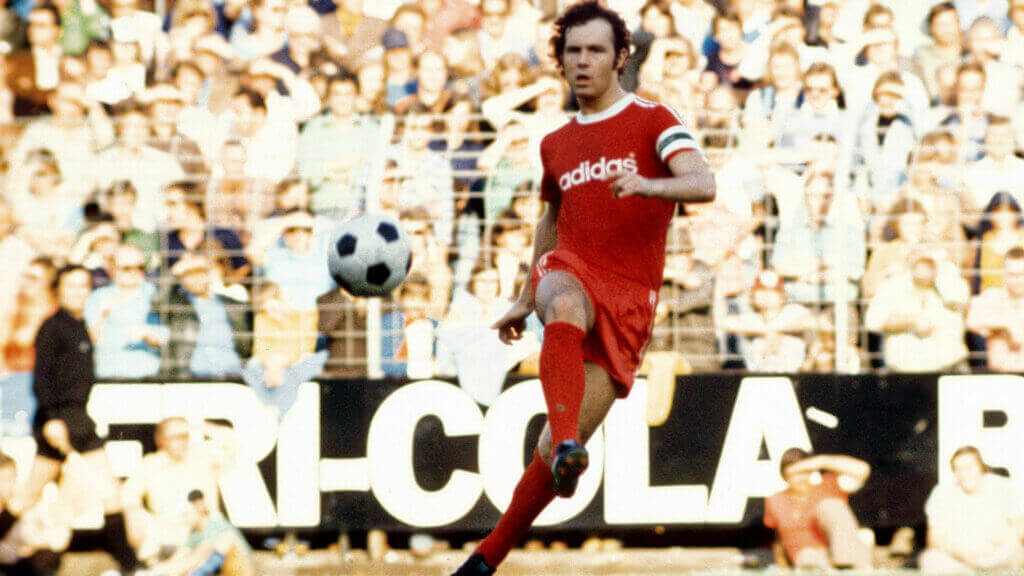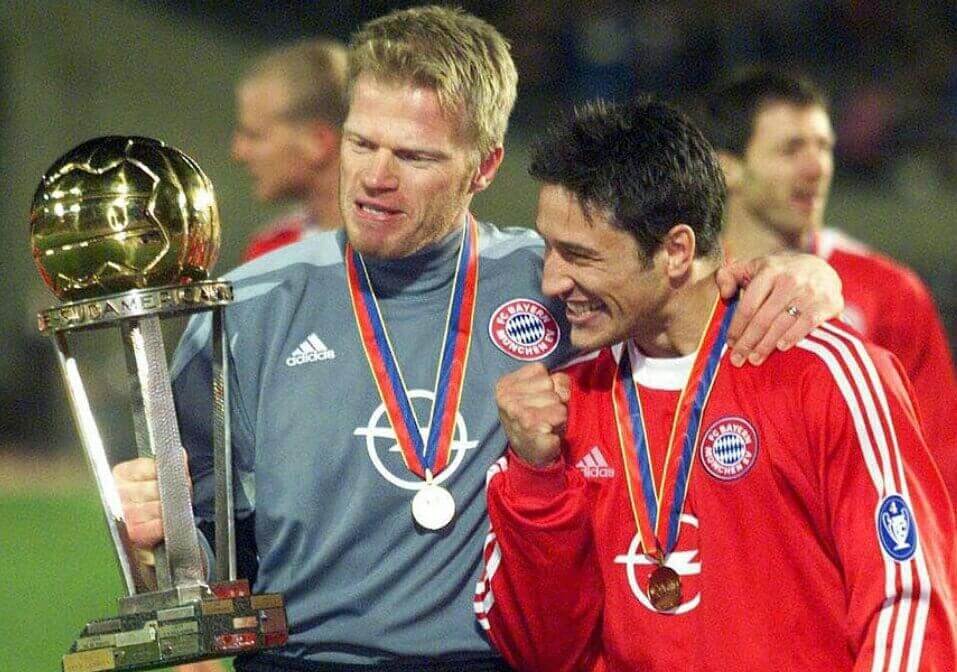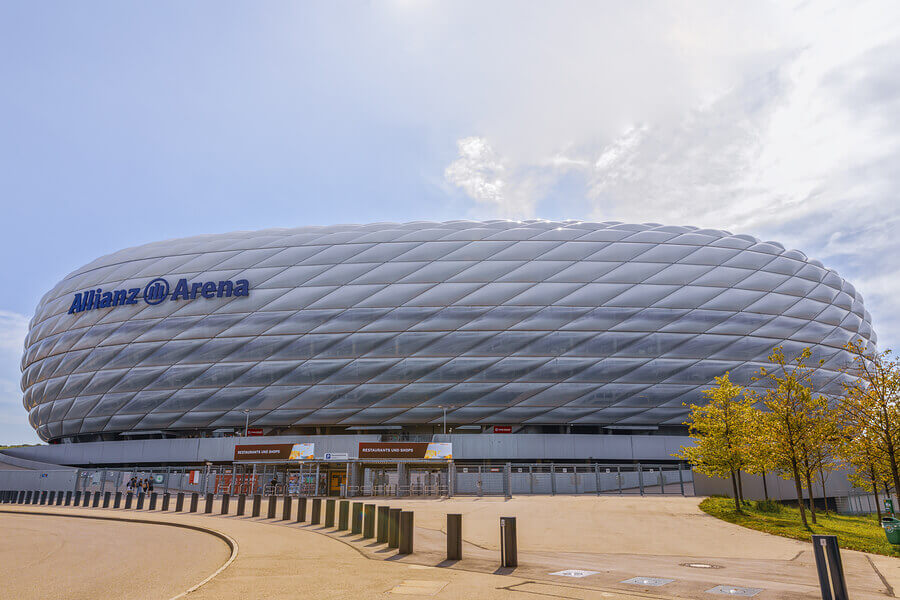The History of Bayern Munich: A Star Was Born

The history of Bayern Munich hasn’t always been as shiny as it is today. The successes and titles of recent decades make it difficult to think that they had to work very hard to get access to the Bundesliga. Here’s everything you need to know about it!
Bayern is one of the most prestigious clubs in the world and whose honorary president is nothing less than Franz Beckenbauer. This club, also known as the giant of Bavaria, is the team with the most Bundesliga titles and has a rich history.
History of Bayern Munich: the beginnings
On February 27, 1900, a group of players from the German city of Munich decided to form a team. They wanted to take part in the Southern Soccer Association of the country. The founding meeting took place in a restaurant: there, they elected the first president, Franz John, and also chose their signature colors: blue and white.
The first field used by Bayern Munich still exists: it’s called Schyrenplatz. There, the team faced Muncher FC. At the time, they defeated Muncher FC by a forceful 5 to 2. That stadium was also the field where they first encountered their city rival.
In order to move forward, the club partnered with another, the Muncher Sport-Club in 1906. Because of the partnership, they agreed to change their colors for those of the other team: white shirt and red pants.
A year later, in 1907, the club got a new home. This would be the first soccer stadium in Munich. A short time later, they played the South German championship, and then the Bavarian region championship as well.
Of course, the early twentieth century was a very hard time for Germany. The situation of their soccer clubs was dire as well. Bayern Munich was no exception!
Even its president and coach, who were of Jewish origin, had to resign and emigrate. The same thing happened to many partners and some players.
After the war, the reconstruction began to take shape. Shortly after, Bayern Munich won its first German Cup. Nevertheless, the team had to wait until the sixties to enjoy true success.

Franz Beckenbauer. Image: FC Bayern Munich.
The new era of the Bavarian club
In the early sixties, the club made several important signings. Nevertheless, they remained excluded from the Bundesliga. This was because there were two teams from Munich, and it was against the rules to have two different teams representing the same city.
The history of Bayern Munich recognizes a golden era, between 1966 and 1979. Then, the team was finally accepted in the German League! Besides, they won the championship five times in that period.
In addition, we can’t ignore that in 1976 they won their first Intercontinental Cup and three UEFA Champions Leagues (1973-1974, 1974-1975 and 1975-1976). The seventies were an amazing decade for the team!
In spite of the winning streak, the eighties were a rough time for the team. Bayern Munich plummeted during the 1980s, due to many financial problems.
However, like a phoenix, they resurfaced from the ashes and entered the next decade going from title to title: they won five Bundesliga titles, two German Cups and one UEFA European League Cup.

Image: Twitter @HomeFCB
The new millennium began and the history of Bayern Munich only got better. They kept up their winning streak with more Bundesligas, German Cups, German Super Cups, Champions Leagues and another Intercontinental. In total, the Bavarian giant has 22 regional titles, 61 national titles, eight European titles, and three world titles. In total, they have an impressive track record of 94 trophies!
The history of Bayern Munich’s stadium changes
As we said before, the team played its first games at Schyrenplatz. After that, they went to Theresienwiese. Finally, in 1901 they inaugurated their own field. They moved to a new location after the merger with the MSC, and in 1920 they changed location again due to space issues.
From 1925 until 1945 the club shared the Grunwalder Stadion with his rival, 1860 Munchen. This venue was destroyed by war.
Nevertheless, because Munich built an Olympic stadium for the 1972 Games, finally Bayern Munich had a home. In turn, they modified this stadium several times to fit their needs.
After many debates, the state of Bavaria, together with Bayern Munich and 1860 Munich, decided to build a new stadium in 2000.
That’s how the Allianz Arena was born. It hosted some matches of the 2006 World Cup in Germany and was left in the hands of the city since then.

Currently, the arena has a capacity for 70,000 spectators, it’s divided into three rows and is commonly known as the “inflatable boat” due to its shape.
Finally, it’s worth noting the motto of Bayern Munich: ‘mia san mia‘. This saying is in Bavarian dialect and it means ‘we are us’. This motto became part of the songs of fans and players: «We are what we are; we are stronger than bulls, we are stronger than trees because we are the true Bavarians ». Are you excited about the next Bundesliga?
The history of Bayern Munich hasn’t always been as shiny as it is today. The successes and titles of recent decades make it difficult to think that they had to work very hard to get access to the Bundesliga. Here’s everything you need to know about it!
Bayern is one of the most prestigious clubs in the world and whose honorary president is nothing less than Franz Beckenbauer. This club, also known as the giant of Bavaria, is the team with the most Bundesliga titles and has a rich history.
History of Bayern Munich: the beginnings
On February 27, 1900, a group of players from the German city of Munich decided to form a team. They wanted to take part in the Southern Soccer Association of the country. The founding meeting took place in a restaurant: there, they elected the first president, Franz John, and also chose their signature colors: blue and white.
The first field used by Bayern Munich still exists: it’s called Schyrenplatz. There, the team faced Muncher FC. At the time, they defeated Muncher FC by a forceful 5 to 2. That stadium was also the field where they first encountered their city rival.
In order to move forward, the club partnered with another, the Muncher Sport-Club in 1906. Because of the partnership, they agreed to change their colors for those of the other team: white shirt and red pants.
A year later, in 1907, the club got a new home. This would be the first soccer stadium in Munich. A short time later, they played the South German championship, and then the Bavarian region championship as well.
Of course, the early twentieth century was a very hard time for Germany. The situation of their soccer clubs was dire as well. Bayern Munich was no exception!
Even its president and coach, who were of Jewish origin, had to resign and emigrate. The same thing happened to many partners and some players.
After the war, the reconstruction began to take shape. Shortly after, Bayern Munich won its first German Cup. Nevertheless, the team had to wait until the sixties to enjoy true success.

Franz Beckenbauer. Image: FC Bayern Munich.
The new era of the Bavarian club
In the early sixties, the club made several important signings. Nevertheless, they remained excluded from the Bundesliga. This was because there were two teams from Munich, and it was against the rules to have two different teams representing the same city.
The history of Bayern Munich recognizes a golden era, between 1966 and 1979. Then, the team was finally accepted in the German League! Besides, they won the championship five times in that period.
In addition, we can’t ignore that in 1976 they won their first Intercontinental Cup and three UEFA Champions Leagues (1973-1974, 1974-1975 and 1975-1976). The seventies were an amazing decade for the team!
In spite of the winning streak, the eighties were a rough time for the team. Bayern Munich plummeted during the 1980s, due to many financial problems.
However, like a phoenix, they resurfaced from the ashes and entered the next decade going from title to title: they won five Bundesliga titles, two German Cups and one UEFA European League Cup.

Image: Twitter @HomeFCB
The new millennium began and the history of Bayern Munich only got better. They kept up their winning streak with more Bundesligas, German Cups, German Super Cups, Champions Leagues and another Intercontinental. In total, the Bavarian giant has 22 regional titles, 61 national titles, eight European titles, and three world titles. In total, they have an impressive track record of 94 trophies!
The history of Bayern Munich’s stadium changes
As we said before, the team played its first games at Schyrenplatz. After that, they went to Theresienwiese. Finally, in 1901 they inaugurated their own field. They moved to a new location after the merger with the MSC, and in 1920 they changed location again due to space issues.
From 1925 until 1945 the club shared the Grunwalder Stadion with his rival, 1860 Munchen. This venue was destroyed by war.
Nevertheless, because Munich built an Olympic stadium for the 1972 Games, finally Bayern Munich had a home. In turn, they modified this stadium several times to fit their needs.
After many debates, the state of Bavaria, together with Bayern Munich and 1860 Munich, decided to build a new stadium in 2000.
That’s how the Allianz Arena was born. It hosted some matches of the 2006 World Cup in Germany and was left in the hands of the city since then.

Currently, the arena has a capacity for 70,000 spectators, it’s divided into three rows and is commonly known as the “inflatable boat” due to its shape.
Finally, it’s worth noting the motto of Bayern Munich: ‘mia san mia‘. This saying is in Bavarian dialect and it means ‘we are us’. This motto became part of the songs of fans and players: «We are what we are; we are stronger than bulls, we are stronger than trees because we are the true Bavarians ». Are you excited about the next Bundesliga?
All cited sources were thoroughly reviewed by our team to ensure their quality, reliability, currency, and validity. The bibliography of this article was considered reliable and of academic or scientific accuracy.
- Garcia, J. El papel del Bayern Múnich en la Alemania Nazi. Milenio. Diciembre de 2019. https://www.milenio.com/deportes/futbol-internacional/bayern-munich-papel-jugado-alemania-nazi
- GOAL. Estadio Allianz Arena: historia, ubicación y capacidad. Noviembre de 2018. https://www.goal.com/es/noticias/estadio-allianz-arena-historia-ubicacion-y-capacidad/1ma295x9dhhi81nilyr2qinbib
This text is provided for informational purposes only and does not replace consultation with a professional. If in doubt, consult your specialist.








